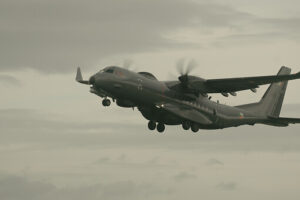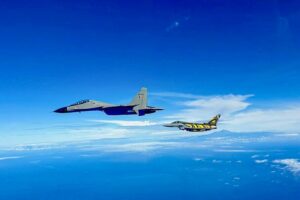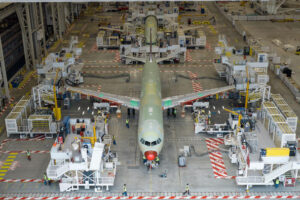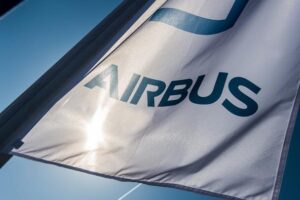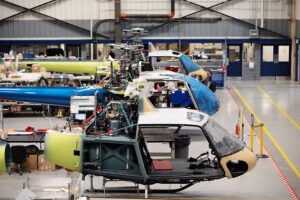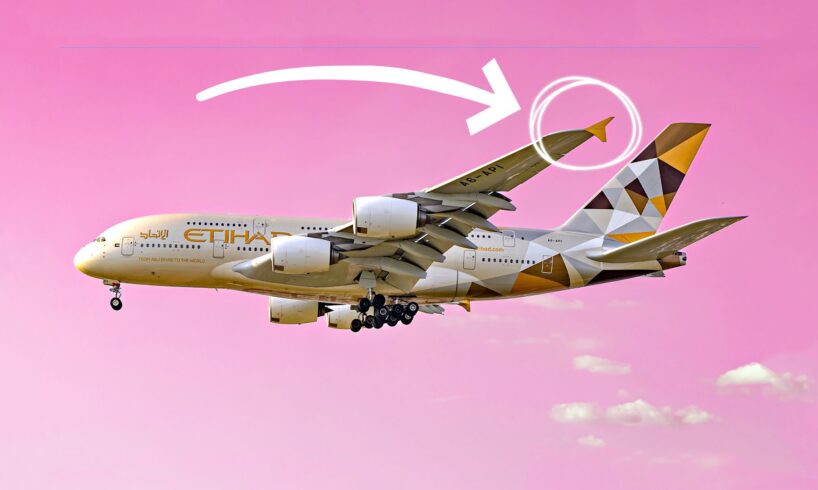
While modern widebody aircraft like the A330neo, A350, Boeing 787, and Boeing 777X use sleek blended or raked wingtips, the Airbus A380 Superjumbo instead uses fenced wingtips found on the Airbus A320ceo. But why? Why didn’t Airbus engineers design the massive aircraft with sleek blended wingtips, and instead go for the older design Airbus first used in the 1980s?
The reasons the Superjumbo is flying today with fenced wingtips have to do with the ICAO airport regulations, cost considerations, and attempts to manage the weight on the already heavy aircraft. Other considerations included the A380’s large high-aspect-ratio wings and unique aerodynamic profile due to its size. Here is why Airbus engineers selected fenced wingtips for the Airbus A380, even though they are not optimal for reducing drag.
Why Wingtips Devices Are Needed
Photo: BlueBarronPhoto | Shutterstock
Wingtip devices help aircraft reduce drag. As a conventional wing generates lift, it experiences lift-induced drag. Higher-pressure air under the wing then flows to the lower-pressure surface on top at the wingtip. SKYbrary states that the direct consequence of this, as far as the wing tips are concerned, is that there is a continual spilling of air upwards around the wing tip, a phenomenon called ‘tip effect’ or ‘end effect’.
The resulting vortex can be countered by increasing the height of the lifting system. This is achieved through a vertical fin or winglet. This reduces drag for the aircraft. Reducing drag allows the aircraft to gain increased fuel efficiency, which, in turn, allows the aircraft to increase its range. Wingtip devices have other benefits as well, including reduced takeoff field length due to improved climb performance, increased cruising speed, and higher cruising altitude.
Commercial passenger aircraft can greatly benefit from wingtip devices. Most notably, they have an average of a 4-6% increase in fuel efficiency. This is significant fuel savings in the context of aviation. Another benefit is reducing the in-flight noise of the aircraft. Commercial aircraft, like the Learjet 28/29, started experimenting with wingtip devices in the 1970s, and the first commercial airliner to incorporate them was the Airbus A310-300 in 1985.
Wingtip Devices Optimized For Different Stages Of Flight
Photo: Wenjie Zheng | Shutterstock
There are multiple types of methods to reduce induced drag from the wing tip vortices. The name, Wing Tip Drag Reduction Device, refers to any one of these, including winglets, blended winglets, wing tip fences, and raked wing tips. Each of these designs comes with its own advantages and compromises. Some provide optimal benefit while at cruise, while others are better optimized for takeoff and climb performance.
The design chosen for a particular aircraft typically reflects the best option for the normal flight profile of that aircraft. For example, regional aircraft flying short routes spend a greater amount of time climbing and descending, while those aircraft dedicated to long-haul routes spend more of their time cruising. Long-range aircraft are better served with wingtip devices that provide optimum cruise performance.
Wingtip devices
Select aircraft types
Wingtip fences
A320ceo, A300-600, A380
Blended winglets
A320neo, A330neo, A350
Raked wingtips
Boeing 777/777X, 787, 747-8, E-Jet E2
Split winglets
Boeing 737 MAX
Wingtip fences are common on some Airbus aircraft. They are found on the A320ceo, the older A300-600, and the Airbus A380 Superjumbo. Meanwhile, the Airbus A320 Enhanced, A320neo, A350, and A330neo all have blended winglets instead of wingtip fences. Raked wingtips are found on the Boeing 767-400ER, Boeing 777, Boeing 777X, the Boeing 787, and the Boeing 747-8, as well as Embraer E-Jet E2. The Boeing 737 MAX has split winglets.
Related
Where To Fly The Airbus A380 Next Year: Airlines & Routes
Find out where the double-decker will be flying to next year.
Pros & Cons Of Wingtip Fences
Photo: Vytautas Kielaitis | Shutterstock
The Airbus A380 Superjumbo is equipped with wingtip fences that provide extended surfaces both above and below the wingtip. As stated, Airbus has used these wingtip fences on its A310-300, A300-600, A320ceo, and A380 aircraft. However, all of these aircraft are now out of production, meaning that Airbus now uses blended winglets for its current aircraft.
Wingtip fences are simpler, lower cost, offer lower structural impact, and do not increase the overall wingspan, which allows aircraft operating at their maximum wing length to remain within gate space limitations. Wingtip fences come with several drawbacks compared with blended winglets. For example, they are less effective at reducing drag, and the sharp angles can introduce parasitic drag. The fuel savings from wingtip fences are lower compared with blended winglets (meaning they are less optimized for long-haul flights).
In all, wingtip fences are considered obsolete with new aircraft like the Airbus A350 that offer sleek blended winglets. It may not be a major concern for engineers, but blended winglets like those on the A350 are considered more visually appealing and modern. However, wingtip fences are a simpler, cost-effective solution for short-to-medium-haul aircraft like the older A320ceos. But this doesn’t explain why Airbus used them on the ultra-long-range A380.
The A380’s Massive Wings & Constraints
Photo: Vidit Luthra l Shutterstock
Airport infrastructure already had to be modified to operate the massive Airbus A380, and this was always a limitation on the aircraft. When Airbus engineers designed the Airbus A380-800, they also designed it with oversized wings optimized for the stretched Airbus A380-900 that never came. The A380 is massive and had to be designed to operate within the ICAO Annex 14 Code F regulations that place an 80-meter (262.5-foot) limit on aircraft wingspan to ensure aircraft are compatible with taxiways, runways, and gates.
The use of ranked wingtips would have increased the A380’s wings and would have forced engineers to decrease the overall size of the wings, which would have had compromises of its own. By using wingtip fences, Airbus engineers were able to keep the Superjumbo’s wingspan to 78.75 meters, just inside the Code F limit.
Select reasons why Airbus chose fenced wingtips for A380
Reduced wing length
Needed to operate within 80-meter Code F regulations.
Unique profile
The A380’s unique aerodynamic profile & high-aspect-ratio wings reduced the need for blended winglets.
Weight saving
Saved weight from heavier blended winglets and the need for more reinforcement.
Experience
Airbus had extensive experience with fenced wingtips.
Cost
It was cheaper to use existing fenced wingtip technology.
The smaller Boeing 787 uses raked wingtips, and this increases the wingspan significantly. But as this is a smaller aircraft, that’s OK. But on the A380, the use of such wingtip devices would have pushed the span over the limit. That would have required costly airport infrastructure modifications, or the wings would need to be downsized. In short, it was a compromise. Meanwhile, the upcoming Boeing 777X has found a workaround by being the first to incorporate folding wingtips.
Related
How Much Longer Are The 777X’s Wings Than The 777’s?
The new 777X will have a broader wingspan than the 777, but folding wingtips when on the ground.
Other Considerations For The A380’s Wing Fences
Photo: vaalaa l Shutterstock
While Code F regulations may have been the leading factor in engineers choosing wingtip fences for the A380, it wasn’t the only factor. The A380’s large, high-aspect-ratio wings are already designed to reduce drag, allowing the wingtip fences to provide a reduced drag reduction of around 2-3%. Blended winglets (or raked wingtips) would have reduced drag further, but those marginal aerodynamic gains were considered less important for the A380.
Another consideration was that the A380 was already a heavy aircraft. Wingtip fences were seen as a way to not add extra weight, as they are smaller and simpler, while putting less stress on the wing root, which in turn, reduces the need for more structural reinforcement. Yet another factor was that Airbus was already digging deep, to the tune of $25 billion, to develop the A380. The tried-and-tested wingtip fence was a cheaper solution.
In all, Airbus decided that wingtip fences reduced the vortices enough, and they felt more comfortable using them thanks to previous Airbus aircraft like the A300 and A320ceo. In some respects, it can be argued that the use of these wingtip devices underscores how the A380 was a big airplane, not a new airplane. The use of traditional materials and inefficient engines compared with the A350 and 787, with their extensive use of lightweight composites and better engines, helped to doom the A380.
A Calculated Trade-Off For The A380
Photo: Minh K Tran | Shutterstock
In all, Airbus engineers saw the fenced wingtips as a worthy compromise. While they do not reduce drag to the same degree as raked or blended wingtips, this was seen as acceptable for the Superjumbo. Critically, they allowed Airbus engineers to design the wings to make maximum use of the Code F limitations they were working with.
Airbus engineers also had a good amount of experience with fenced wingtips, and they saw them as a way to reduce the overall cost of developing the Superjumbo, while also cutting down on the aircraft’s already heavy weight. This is a limitation Airbus engineers are now free from with newer aircraft like the A350 and A330neo.
RUAG Aerostructures produces the wingtips for the A380 and says that they produce less resistance with high lift coefficients, better stability around the lift axis, and greater maneuverability around the longitudinal axis. Still, these are not ideal. Designs are often a trade-off, and Airbus engineers thought the trade-off of using fenced wingtips was the right balance between reducing drag and other considerations. With the A380, Airbus bet on the hub-and-spoke model to be the future of aviation; it lost to its own A350 and Boeing, which bet on more flexible point-to-point travel with its 787.
ICAO Code
A388
IATA Code
388
Amount Built
243
Crew
2
Passengers
525 – 644

